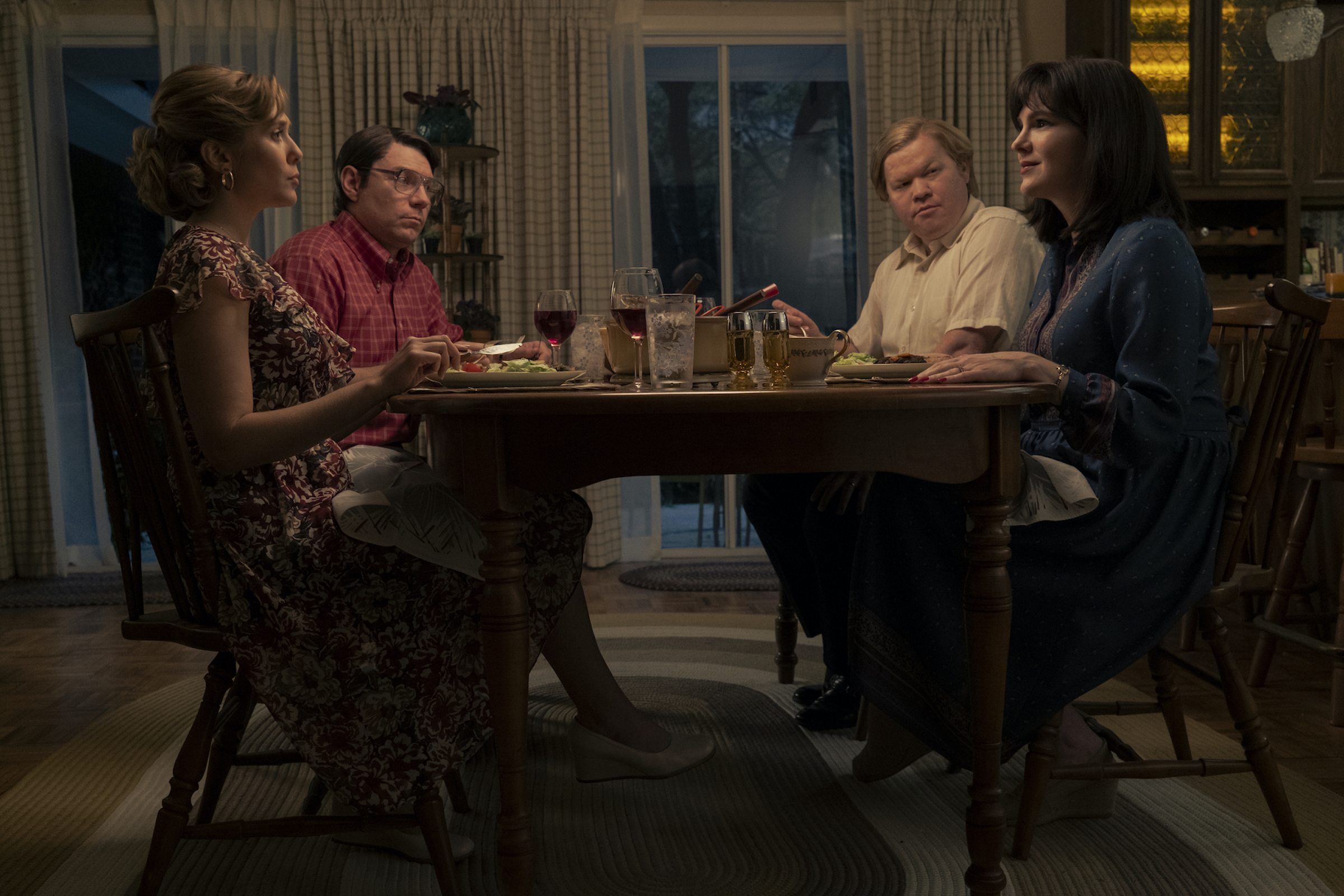Nobody was supposed to get hurt. This is the irony that drives Love & Death, creator David E. Kelley’s empathetic HBO Max docudrama based on the true tragedy that befell two young, churchgoing couples raising families in small-town Texas in the late 1970s. When starry-eyed Candy Montgomery (Elizabeth Olsen) talks pragmatic Allan Gore (Jesse Plemons) into having an affair with her, over the course of many anxious “strategy sessions,” the lovers-to-be agree: neither of their spouses, especially Allan’s psychologically fragile wife Betty (Lily Rabe), can ever find out about them. They set up rules, meeting only on weekdays, at an out-of-town motel. Candy packs them a meal to share, in order to conserve time on Allan’s lunch breaks. As adultery goes, it’s all kind of adorable—until it really isn’t.
If you followed the media-magnet case as it unfolded, or watched last year’s Hulu miniseries on the same subject, Candy, which contains many of the same dramatized scenes, then you already know that Betty Gore died on June 13, 1980, and that Candy stood trial for her murder. Considering how much exposure this story has already gotten, it makes sense that Kelley, in his best show since Big Little Lies, shows little interest in the investigative aspects of the story. In a corrective to rampant true-crime sensationalism, Love & Death paints a portrait of regular, unmalicious people trapped in a terrible predicament that they set into motion but do not, perhaps, deserve.
Olsen’s Candy is a complicated woman. Beloved in her community and active in her church, the extroverted stay-at-home mom is languishing in her marriage, to quiet engineer Pat (Patrick Fugit). Her only outlet, aside from frank conversations with her dear friend and pastor, Jackie (Elizabeth Marvel), is a writing workshop. So when Allan—dorky, doughy Allan—accidentally knocks her down, then gently helps her up, at a church volleyball game, Candy spins herself a fantasy. “He smelled like sex,” she tells a friend. Disarmingly confident in her desire, she approaches Allan with a no-nonsense proposal: “Would you be interested in having an affair?”
Read more: The 47 Most Anticipated Shows of 2023

It takes her a while to get him, a constitutionally nervous guy who’s worried about his oddball wife, to yes. Part of the calculation is that their arrangement must be about sex and adventure, not love, which each is adamant on reserving for their respective spouse. Candy sees the fact that Allan doesn’t exactly resemble her dream date as a safeguard against catching feelings.
But feelings don’t always behave the way we expect. Tenderness creeps into their rendezvous. At first, Allan is too shy to shower with Candy after they sleep together. She has to teach him how to French-kiss. It’s moving, but also stressful, to watch their intimacy grow. “I’m getting in too deep,” Candy realizes one day. “I don’t want to fall in love with you.” Of course, by then it’s already too late.
These early episodes, in which Candy and Allan find themselves falling for each other and struggle to navigate the emotional tumult they’ve created, are the most absorbing of the series. Maybe that’s surprising, given that the blood, cops, and courtroom theatrics are still to come. But we’ve seen all of that stuff before, in other true-crime procedurals if not in Candy. Aside from a layered performance by Olsen that easily surpasses the wig-forward acting of Candy’s miscast Jessica Biel, what sets Love & Death apart from its predecessor, and so many other superficial, ripped-from-the-headlines murder shows (Dahmer—Monster, The Thing About Pam, The Serpent), is Kelley’s refusal to reduce real people to cartoon killers or weirdos or fools.
It’s a welcome course correction from the prolific creator, whose post–Big Little Lies litany of rich-lady thrillers, from The Undoing to Nine Perfect Strangers to Anatomy of a Scandal, has suffered from similarly broad characterizations. After immersing us in the secret idyll that two utterly distinctive lovers create in a generic Texas motel room, Kelley, who wrote every episode, illuminates the people around them. We observe Betty’s brittleness, Pat’s unarticulated devotion, the hair-trigger temper of a hometown lawyer (Tom Pelphrey) trying his hand at criminal defense for the first time, the desperation of a young pastor (Keir Gilchrist) whose priggishness keeps losing his church congregants.
Read more: The 16 Best True Crime Books of All Time

Candy and Allan gain new dimensions, in turn, under public scrutiny. Her fixation on the way other people perceive her comes to the fore. He seems caught between his ex-girlfriend and his dead wife, palpably guilty but allergic to self-reflection. While the local Methodist church functions as a default third space for this community—and just about everyone seems spiritually lost when Gilchrist’s Ron replaces Jackie—Kelley takes pains to avoid representing their lives as some fundamentalist freak show.
Adapted from John Bloom and Jim Atkinson’s 1983 nonfiction book Evidence of Love: A True Story of Passion and Death in the Suburbs and a collection of Texas Monthly articles by the same authors, Love & Death can sometimes get bogged down in mundane details. Amid so many other nuanced supporting characters, it’s puzzling to see the wonderfully spiky Krysten Ritter wasted in a one-note role as Candy’s most loyal confidant. And like most streaming docudramas, it could’ve been significantly shorter. Still, what makes Kelley’s potentially redundant retelling of a well-worn story worth watching is the human heart at its core. For once, the love resonates as profoundly as the death.
More Must-Reads from TIME
- Caitlin Clark Is TIME's 2024 Athlete of the Year
- Where Trump 2.0 Will Differ From 1.0
- Is Intermittent Fasting Good or Bad for You?
- The 100 Must-Read Books of 2024
- Column: If Optimism Feels Ridiculous Now, Try Hope
- The Future of Climate Action Is Trade Policy
- FX’s Say Nothing Is the Must-Watch Political Thriller of 2024
- Merle Bombardieri Is Helping People Make the Baby Decision
Contact us at letters@time.com